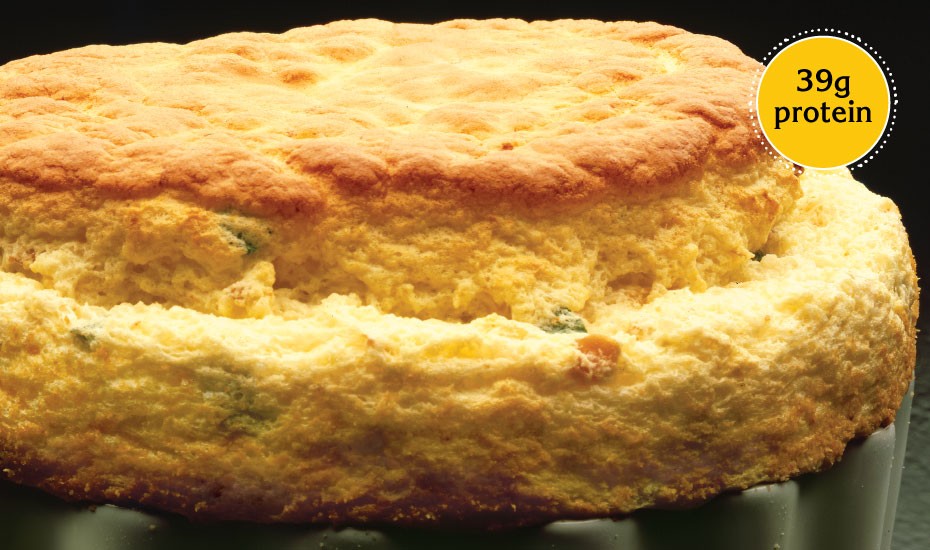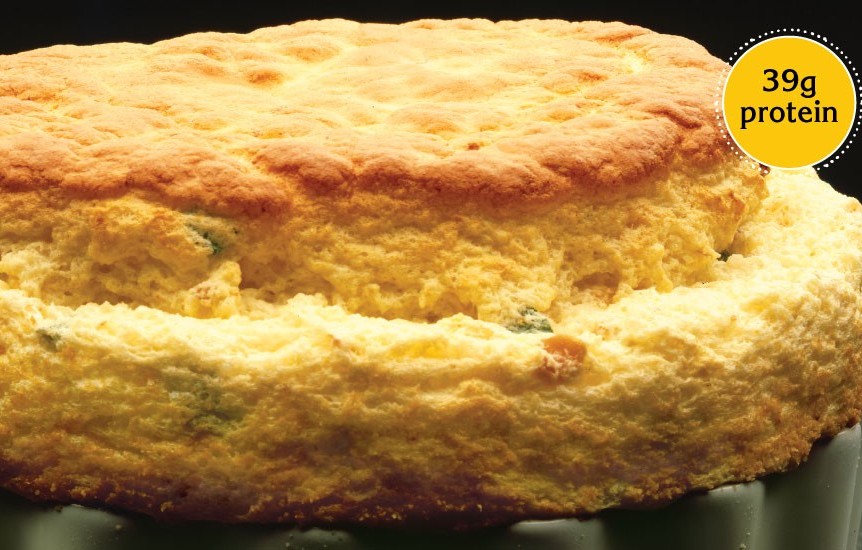

Directions
Heat oven to 350°F. MIX flour and salt in medium saucepan; gradually whisk in milk until smooth. Cook over medium-high heat, stirring constantly, until mixture thickens and boils. Reduce heat to low. Add cheese; stir until melted. Remove from heat.
Beat egg whites and cream of tartar in mixer bowl with whisk attachment on high speed just until whites are stiff but not dry, and no longer slip when bowl is tilted.
Stir egg yolks into cheese sauce until blended. Gently but thoroughly folk yolk mixture into whites until no streaks of white remain. Carefully pour into ungreased 1-1/2 to 2-quart soufflé dish.
Bake in 350°F oven until soufflé is puffy, delicately browned and shakes slightly when oven rack is moved gently back and forth, 30 to 40 minutes. Serve immediately.
Soufflés need something to cling to. Soufflés are baked in ungreased dishes so they can cling to the sides on their ascent. If a coating is desired, lightly grease the dish with butter or cooking spray; then dust evenly and completely with grated Parmesan cheese, fine dry bread crumbs or cornmeal. The coating will keep the soufflé from slipping down to the bottom.
Straight sides make all the difference. The straight sides of the traditional soufflé dish help the soufflé to climb and hold itself up. You can substitute a straight-sided casserole or saucepan (with ovenproof handle). If using a nonstick saucepan, be sure to coat the sides (as described above) to provide a non-slip surface.
How high do soufflés rise? A soufflé can double or even triple in volume. It depends on your beating and folding skills and on the weight of any added ingredients you use.
Use the appropriate size dish. The soufflé mixture should fill the dish to about 1/2 inch from the top. If the dish is too small, the soufflé will overflow; if too big, it may not rise above the rim and not look elegant. A 4-egg soufflé usually requires a 1-1/2 to 2-quart dish; a 6-egg soufflé needs a 2 to 2-1/2 quart dish.
Collaring the dish: If the soufflé dish is a bit too small, you can add a collar to the dish before baking. Make a triple thick 4-inch wide band of aluminum foil, long enough to go around the dish and overlap by 2 inches. Grease and coat one side of the band (as described above). Wrap the band around the outside of the dish, coated side facing in. Fasten with string or strong masking tape. The collar should extend at least 2 inches above the top of the dish. It will keep the soufflé in bounds when it bakes. (Quickly but gently remove the collar from the baked soufflé before bringing it to the table.)
Keep the yolks separate from the whites. Fat from egg yolk will prevent egg whites from beating up properly. When separating eggs, take care that no yolk gets in the whites. To avoid an accident, separate each egg white into a cup or small bowl before transferring it to the mixer bowl. Discard any white that has even a speck of yolk in it.
Equipment: Beaters and bowl should be spotlessly clean. Any residue of fat will prevent egg whites from beating up properly. Use a stainless steel or glass bowl. Plastic bowls can retain a film of grease.
Egg temperature: It’s easiest to separate eggs cleanly when they are refrigerator cold. However egg whites whip up to greater volume when they’ve had a chance to warm up a bit, 20 to 30 minutes. Always begin by separating the eggs. Let the whites stand at room temperature while you prepare the sauce and other ingredients.
Cream of tartar: The air beaten into egg whites can be lost quite easily. A small amount of acidic ingredient, such as cream of tartar, acts as a stabilizing agent. A bit of lemon juice or vinegar will also work.
Salt decreases egg-white foam stability, so it should be added to the other ingredients.
Beat egg whites just until they are stiff but not dry and no longer slip when the bowl is tilted. When underbeaten, whites will not achieve full volume. Overbeaten whites form clumps of dry puffs which don’t hold air well, are difficult to incorporate when folding and do not expand properly when baked.
Gentle folding is the key to maintaining volume. Combining heavier mixtures with beaten egg whites can knock the air out of them. To prevent this, begin by pouring the egg yolk mixture over the beaten whites, not vice versa. Then gradually and gently combine the mixtures by folding, rather than stirring. Using a rubber spatula, start with a downward stroke into the bowl, continue across the bottom, up the side and over the top of the mixture. Come up through the center every few strokes and rotate the bowl often as you fold. Fold just until the color of the mixture is uniform, with no streaks of white remaining.
To create a “top hat” (a center that rises higher than the sides): Hold a metal spatula or table knife upright and make a ring in top of the unbaked soufflé mixture, 1 inch from side of dish and 1 inch deep.
Don’t open the oven door! A cool draft or slammed oven door can easily deflate the soufflé. Resist the urge to peek, at least during the first 25 minutes of baking.
Make ahead: The best soufflé is baked immediately. If necessary, it can be refrigerated up to 2 hours before baking. An unbaked soufflé can be frozen for several weeks, if you’re willing to sacrifice some puff. Defrost it in the refrigerator before baking.
